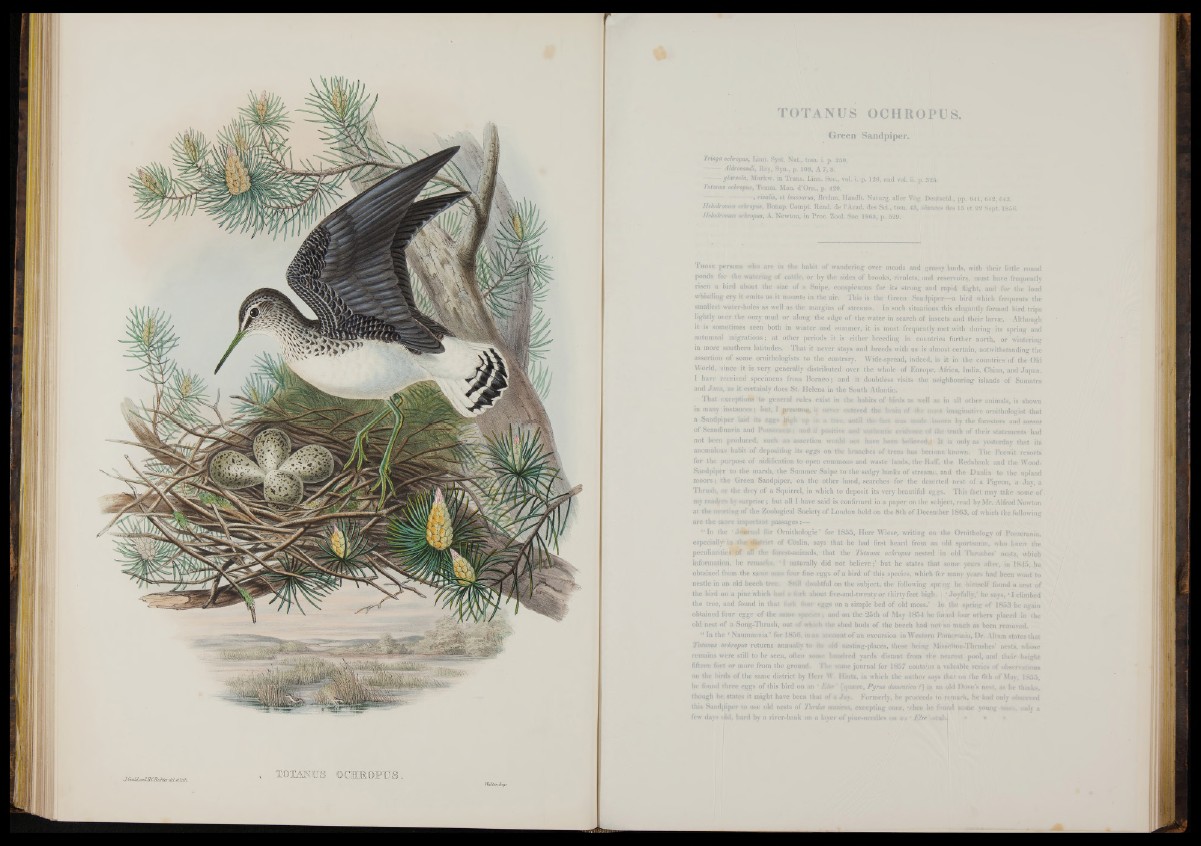
TOTANUS OCHROPU8.
Green Sandpiper.
Tringa ochropus, Linn. Syst. Nat., tom. i. p. 250.
Aldrovand'u R Syn., p. 108, A 7, 8.
fflareola. Markw. in Trans. Linn. Soc., vol. i. p. 128, and vol. S. p. 32ii.
Totanus ochropus, Temm. Man. d’Om., p. 420.
, rivalis, et leucourus, Brehm, Handb. Naturg. aller Voj;. Deutschl., pp. 641, 642, 643.
Helodromos ochropus, Bonap. Compt. Rend, de l'Acad. des Sci., tom. 43,; séances des 15 et 22 Sept. I85f
Helodromas ochropus, A. Newton, in Proc. Zool. Soc. 1863, p. 529.
T hose persons who are hi the habit of wandering over meads and; grassy lands, with their little round
ponds for the watering of cattle, o r by the sides of brooks, rivulets, and reservoir^, must have frequently
risen a bird about the size of a Snipe, conspicuous for its strong and rapid flight, and for the loud
whistling cry it emits as it mounts in the air. This is the Green San lpiper—a bird which frequents the
smallest water-holes as well as the margins of streams. In such situations this elegantly formed bird trips
lightly over the oozy mud or along the edge o f the water in search of insects and their lame. Although
it is sometimes seen both in winter and summer, it is most frequently met with during its spring and
autumnal migrations; a t other periods it is either breeding in countries further north, or wintering
in more southern latitudes. That it never stays and breeds with us is almost certain, notwithstanding the
assertion of some ornithologists to the contrary. Wide-spread, indeed, is it in the countries o f the Old
World, since it is very generally distributed over the whole of Europe, Africa, India, China, and Japan.
I have ijeeeived specimens from Borneo ; and it doubtless visits the neighbouring islands of Sumatra
and Java), as it certainly does St. Helena in the South Atlantic.
That pxceptioBB to general rules exist in the habits of birds as well as in all other animals, is shown
in many I instances; bet, I presame, it never entered the b'-ain of the jutr-l imaginative ornithologist that
a Sandpiper laid its eggs wp u, a tree, anti] the feet was wade ¡too*» by the foresters and smans
of Scandinavia and Pomerao«* mid if positive and authentic evtdeeee o f the truth o f their statements had
not been produced, such an assertion would not have been believed, j I t is only as yesterday that its
anomalous habit o f depositing its eggs on the branches of trees has became known. The Peewit resorts
for the purpose o f nidification to open commons and waste lands, the Ruff, the Redshank and the Wood-
Sandpipi:r to the marsh, the Summer Snipe to the sedgy banks o f stream: , and the Dunlin to the upland
m oors: (the Green Sandpiper, on the other hand, searches for the descirted nest of a Pigeon, a Jay, a
Thrush, or the drey o f a Squirrel, in which to deposit its very beautiful eggs. This fact may take some of.
my reader* by surprise; but all I have said is confirmed in a paper on the subject, read by Mr. Alfred Newton
a t the meeting o f the Zoological Society o f London held on the 8th of December 1863, o f which the following
are the more important passages:—-
“ In the 1 v/0Ui>- ,: fur Ornithologie ’ for 1855, He rr Wiese, writing on the Ornithology of Pomerania,
o f Coslin, says that he had first heard from an old sportsman, who knew the
>>■■' st-animals, that the Totanus ochropus nested in old Thrushes’ nests, which
11 naturally did not b e l i e v e b u t he states that some years after, in 1845, he
aw four fine eggs of a' bird of this species, which fo r many years had been wont to
i,Still doubtful on the subject, the following s p rn g he iiimself found a nest of
i ad a fork about five-and-twenty or thirty feet high. 1 ‘ Joyfully,’ he says, ‘ I climbed
it fork fear eggs on a simple bed o f old moss.’ In tl^i spring o f 1853 he again
on the 25th of May 1854 he IbVrid four others placed in the
hed buds o f the beech had imwbo much as been removed,
at o f an excursion in Western f’omerania, D r. Altum states that
nesting-places, these bring Misseltoe-Thrushes’ nests, whose
dred yards distant from tjfe nearest pool, and th e ir' height
me journal for 1857 contains a valuable series of observation*
iiiitz, in which the author says that on the 6th o f May, 1855,
[quaere, Pyrus domestica f] in an old Dove’s nest, as he thinks,
lay. Formerly, he proceeds to. remark, he had only observed
cut, excepting once, when he found some young /on«;.-, only a
>f pine-needles on *4 * Else -stubJ * * *
especially'' ijn .thi? tfe
peculiaritiejs 6? all
information, he rem
obtained from the sa
nestle in an old beech tree. $
the bird on a pine which had a
the tree, and found in that tor
obtained four eggs o f the sain*
old nest o f a Song-Thrush, out o f which tl«
“ In the * Naumannia ’ for 1856, in an aeei
Totanus ochropus returns annually to it* oi
remains were still to be seen, often some h
fifteen feet o r more from the ground. The
on the birds o f the same district by Herr W
he found three eggs o f this bird on an ‘ Ebs*
though he states it might have been that of
this Sandpiper to use old nests of Turdus m
few davs ( id, hard by a river-bank on a laye